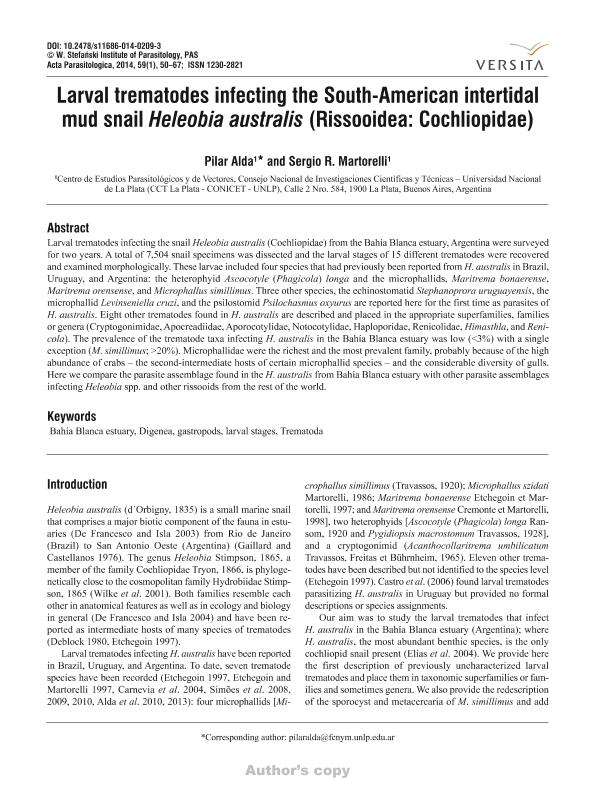Artículo
Larval trematodes infecting the South-American intertidal mud snail Heleobia australis (Rissooidea: Cochliopidae)
Fecha de publicación:
02/2014
Editorial:
Versita
Revista:
Acta Parasitologica
ISSN:
1230-2821
Idioma:
Inglés
Tipo de recurso:
Artículo publicado
Clasificación temática:
Resumen
Larval trematodes infecting the snail Heleobia australis (Cochliopidae) from the Bahía Blanca estuary, Argentina were surveyed for two years. A total of 7,504 snail specimens was dissected and the larval stages of 15 different trematodes were recovered and examined morphologically. These larvae included four species that had previously been reported from H. australis in Brazil, Uruguay, and Argentina: the heterophyid Ascocotyle (Phagicola) longa and the microphallids, Maritrema bonaerense, Maritrema orensense, and Microphallus simillimus. Three other species, the echinostomatid Stephanoprora uruguayensis, the microphallid Levinseniella cruzi, and the psilostomid Psilochasmus oxyurus are reported here for the first time as parasites of H. australis. Eight other trematodes found in H. australis are described and placed in the appropriate superfamilies, families or genera (Cryptogonimidae, Apocreadiidae, Aporocotylidae, Notocotylidae, Haploporidae, Renicolidae, Himasthla, and Renicola). The prevalence of the trematode taxa infecting H. australis in the Bahía Blanca estuary was low (<3%) with a single exception (M. simillimus; >20%). Microphallidae were the richest and the most prevalent family, probably because of the high abundance of crabs — the second-intermediate hosts of certain microphallid species — and the considerable diversity of gulls. Here we compare the parasite assemblage found in the H. australis from Bahía Blanca estuary with other parasite assemblages infecting Heleobia spp. and other rissooids from the rest of the world.
Palabras clave:
Bahia Blanca Estuary
,
Digenea
,
Gastropods
,
Trematoda
Archivos asociados
Licencia
Identificadores
Colecciones
Articulos(CEPAVE)
Articulos de CENTRO DE EST.PARASITOL.Y DE VECTORES (I)
Articulos de CENTRO DE EST.PARASITOL.Y DE VECTORES (I)
Citación
Alda, Maria del Pilar; Martorelli, Sergio Roberto; Larval trematodes infecting the South-American intertidal mud snail Heleobia australis (Rissooidea: Cochliopidae); Versita; Acta Parasitologica; 59; 1; 2-2014; 50-67
Compartir
Altmétricas




